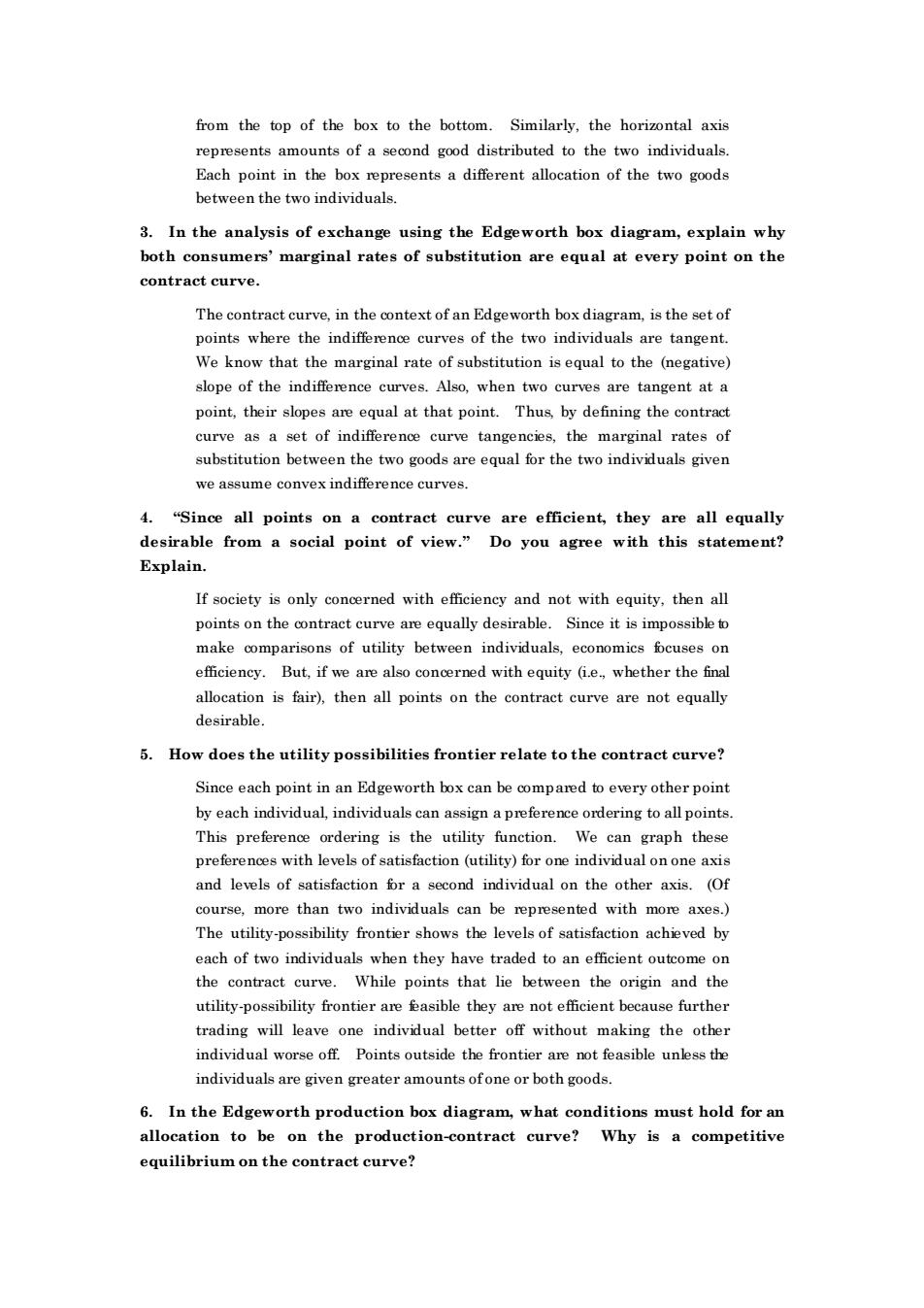正在加载图片...

from the top of the box to the bottom.Similarly,the horizontal axis penof eond时dtit加theindivd represents a different allocation of the two goods between the two individuals 3.In the analysis of exchange using the Edgeworth box diagram,explain why both consumers'marginal rates of substitution are equal at every point on the contract curve. The contract curve.in the context of an edgeworth box diagram.is the set of of the two individual tange We know that the marginal 1 rate of substitut to the negative) slope of the indifference curves.Also,when two curves are tangent at a point,their slopes are equal at that point.Thus by defining the contract curve as a set of indifference curve tangencies.the marginal rates of substitution between the two goods are equal for the two individuals given we ass ame convex indifference curves 4. "Since all points on a contract curve are efficient,they are all equally desirable from a social point of view." Do you agree with this statement? Explain. If society is only concerned with efficiency and not with equity.then all points on the contract curve are equally desirable.Since it is impossible to make comparisons of utility between individuals.economics focuses on whether the final allocation is fair),then all points on the contract curve are not equally desirable. 5.How does the utility possibilities frontier relate to the contract curve? Since each point in an Edgeworth box can be compared to every other point by each individual,individuals can assign a preference ordering to all points This preference ordering is the utility function. Wa can (utility)f raph these pref ith lev one individual one ax and levels of satisfaction scond individual on the other axis. course,more than two individuals can be represented with more axes.) The utility-possibility frontier shows the levels of satisfaction achieved by each of two individuals when they have traded to an efficient outcome on the contract While points that lie between the origin utility-possibility theyare not bcause furthe trading will leave one individual better off without making the other individual worse off.Points outside the frontier are not feasible unless the individuals are given greater amounts ofone or both goods. 6.In the Edgeworth production box diagram,what conditions must hold for an allocation to be on the production-contract curve?Why is a competitive equilibrium on th econtract curve? from the top of the box to the bottom. Similarly, the horizontal axis represents amounts of a second good distributed to the two individuals. Each point in the box represents a different allocation of the two goods between the two individuals. 3. In the analysis of exchange using the Edgeworth box diagram, explain why both consumers’ marginal rates of substitution are equal at every point on the contract curve. The contract curve, in the context of an Edgeworth box diagram, is the set of points where the indifference curves of the two individuals are tangent. We know that the marginal rate of substitution is equal to the (negative) slope of the indifference curves. Also, when two curves are tangent at a point, their slopes are equal at that point. Thus, by defining the contract curve as a set of indifference curve tangencies, the marginal rates of substitution between the two goods are equal for the two individuals given we assume convex indifference curves. 4. “Since all points on a contract curve are efficient, they are all equally desirable from a social point of view.” Do you agree with this statement? Explain. If society is only concerned with efficiency and not with equity, then all points on the contract curve are equally desirable. Since it is impossible to make comparisons of utility between individuals, economics focuses on efficiency. But, if we are also concerned with equity (i.e., whether the final allocation is fair), then all points on the contract curve are not equally desirable. 5. How does the utility possibilities frontier relate to the contract curve? Since each point in an Edgeworth box can be compared to every other point by each individual, individuals can assign a preference ordering to all points. This preference ordering is the utility function. We can graph these preferences with levels of satisfaction (utility) for one individual on one axis and levels of satisfaction for a second individual on the other axis. (Of course, more than two individuals can be represented with more axes.) The utility-possibility frontier shows the levels of satisfaction achieved by each of two individuals when they have traded to an efficient outcome on the contract curve. While points that lie between the origin and the utility-possibility frontier are feasible they are not efficient because further trading will leave one individual better off without making the other individual worse off. Points outside the frontier are not feasible unless the individuals are given greater amounts of one or both goods. 6. In the Edgeworth production box diagram, what conditions must hold for an allocation to be on the production-contract curve? Why is a competitive equilibrium on the contract curve?